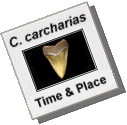| |
Carcharodon carcharias LINNAEUS 17581, the Great white, is a circumglobal apex predator of temperate and subtropical waters. It is primarily found over continental and insular shelves, but may enter bays or cross oceans. Despite claims of this shark reaching 11 meters; FishBase (Jun 2008) lists 8m as total length and Compagno (2001:105) notes that reports in excess of 6.5m are hard to verify. An opportunistic feeder, its diet includes cephalopods, teleosts, sharks/rays and marine mammals.
 The Great white dentition is a highly developed cutting-design; In general, the teeth are broad (particularly the uppers), triangular, labio-distally compressed (more so in uppers) and bear coarse and irregular serrations. Upper teeth are larger and upper laterals more distally inclined than their lower counterparts, The anterior hollows (bullae) each have three teeth, with the upper 3rd (intermediate to some) mesially directed. The lateral hollows may be said to have four large mesiolaterals and 4-6 smaller distolaterals. These dentitions can be broadly grouped into two general designs: narrow (high) and broad (low)-cusped. Hubbell (1996 & pers. com.) notes that these two adult forms cannot be attributed to sex. Neonate & juvenile dentitions are cutting/clutching in design and the teeth (primarily neonate) bear small lateral cusplets.
The Great white dentition is a highly developed cutting-design; In general, the teeth are broad (particularly the uppers), triangular, labio-distally compressed (more so in uppers) and bear coarse and irregular serrations. Upper teeth are larger and upper laterals more distally inclined than their lower counterparts, The anterior hollows (bullae) each have three teeth, with the upper 3rd (intermediate to some) mesially directed. The lateral hollows may be said to have four large mesiolaterals and 4-6 smaller distolaterals. These dentitions can be broadly grouped into two general designs: narrow (high) and broad (low)-cusped. Hubbell (1996 & pers. com.) notes that these two adult forms cannot be attributed to sex. Neonate & juvenile dentitions are cutting/clutching in design and the teeth (primarily neonate) bear small lateral cusplets.
 The fossil record has led to numerous interpretations of the Great white's origin which has been touched upon elsewhere on the website. In general, it is the website's position that:
The fossil record has led to numerous interpretations of the Great white's origin which has been touched upon elsewhere on the website. In general, it is the website's position that:
The Great white dentition evolved by the addition of serrations to the broad-form Cosmopolitodus hastalis (aka xiphodon) teeth during the Late Miocene - Early Pliocene along the Pacific rim.

The Great white (lamnid) did not evolve from the megatoothed Carcharocles megalodon (otodontid) lineage.
The included links and slideshows discuss this topic more fully. There is certainly more that will be learned about Great white evolution in the future, and today's suppositions may be challenged by new facts.
Footnotes
| 1. |
Over the years, there have been attempts to erect regional species, none of which has proven valid. Compagno (2001: 99) provides a succinct overview of this topic. |
References
Compagno, L., 2001. 2001. Sharks of the World, an annotated and illustrated catalogue of shark species known to date - Bullhead, mackerel & carpet sharks. FAO Species Catalogue for Fishery Purposes, No 1, Vol 2. FAO Rome. 269pp
Ehret, D., G. Hubbell and B. MacFadden, 2009. Exceptional preservation of the White shark Carcharodon (Lamniformes, Lamnidae) from the Early Pliocene of Peru. Jrnl. Vert. Paleo. 29(1):1-13.
Ehret, D., B. MacFadden, and R. Salas-Gismondi, 2009. Caught in the act: trophic interactions between a 4-million-year-old white shark (Carcharodon) and mysticete whale from Peru. Palaios, V. 24, pp 329-333
Froese, R. & D. Pauly, Editors. 2003. FishBase. World Wide Web electronic publication. www.FishBase.org, version April 2008.
Hubbell, G., 1996. Using tooth structure to determine the evolutionary history of the white shark. In The Biology of the White Shark, Carcharodon carcharias. A. P. Klimley & D. G. Ainley eds. Academic Press, San Diego CA, USA. pp. 9-18.
|